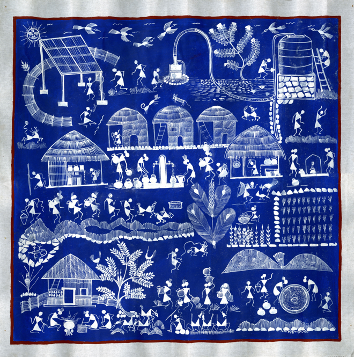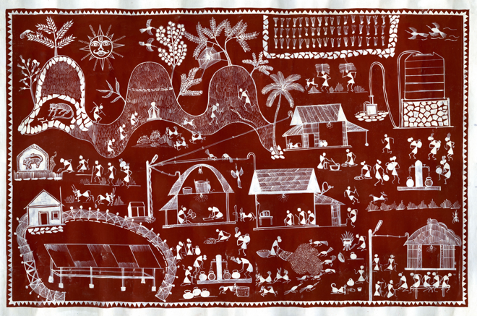Announcements

Gifts of the Northern Sun Exhibit and Call for Art
The Solar Commons Research Project is inviting artists of Native heritage (descendant or enrolled) who live in, or identify with Northern Minnesota and the Lake Superior Region to contribute art images that express to them, the idea of ‘gathering the sun’ in an online exhibit called “Gifts of the Northern Sun.” There is both a Juried Exhibit and a Community Exhibit. Learn More and Explore at the Exhibit website.

Overview
Welcome to the Gallery of Solar Commoning! The Gallery of Solar Commoning explores the way that the sun’s common wealth gifts are appreciated, and the technology of solar energy is culturally integrated in communities around the world.
.…. Here you will find work we have solicited from artists the world over.
SEEING ELECTRICITY:
WHERE IT COMES FROM, WHAT IT MEANS IN OUR WORLDS
An Exhibit at the Snooty Fox Tea Shop
Duluth Minnesota (2016-2018)
Text by Kathryn Milun

The Warli are one of India’s most ancient and earliest agricultural peoples. “Warla” means “piece of land” and Warli art is made using the sustaining elements of their rural lifeworld: white rice paste against the red soil fertility of earth. The stick figure art form, still visible on 10,000-year-old petroglyphs in central India, depicts sacred relationships among Warli and the natural world as well as scenes of everyday life. Warli painting was traditionally done by women on inner walls of village huts for important rituals like marriage and harvest festivals. In the 1970s village men applied the form to canvas so it could be sold in art markets and bring income to forest communities experiencing the encroaching impacts of India’s industrialization. Like many indigenous peoples in South Asia, the Warli live in remote, mountainous forest areas and are among the 300 million Indians—one third of India’s population–who do not yet have electricity.

These paintings were commissioned in the summer of 2016 from a Warli Art Cooperative of men living in Maharashtra villages recently electrified by solar microgrids. I heard that the Warli were using a strategic community solar ownership model aimed, like the Solar Commons Model, to link solar electricity to social equality. The Warli are experimenting with owning their solar array as a community trust requiring half the Board of Trustees to be women and thus empowering women’s role in village governance. Knowing this, I asked my Indian collaborator, Prof. Aparna Katre, who was visiting the Warli’s remote villages in 2016, to ask the local artists if they could show us how the new force of electricity is impacting village life. These three paintings are their response. Before and after scenes show women who used to walk up and down the mountainous terrain for hours everyday fetching water for their families and crops; the women now fill their water jugs at a central village pump. Children can be seen reading and watching internet and TV screens at home. Villagers socialize outside at night beneath a lamp without fear of unseen forest predators. The artists help us see the energy infrastructure, where the electricity comes from as well as the work, life ways, social change and social equality it enables—all of it embedded in a world filled with the diverse animals and plants that the Warli revere.
India is in the process of bringing electricity to all its 1.3 billion people and as it does, it will use the resources it has at hand. Solar is a good and clean source of electric power for remote villages, but coal is abundant in India and will play a big role in powering India’s expanding electric grid just as it has in Europe and the US. New coal-burning power plants now send electricity through India’s transmission grid expanding high and low across the countryside to run industrial cities, bring light to towns, pump water from distant wells, cook food without dangerous fumes, and connect hamlets to the global internet. Coal often lies beneath the forested hills of indigenous peoples’ villages. Just as we have seen in the US with the Dakota Access Pipe Line and the Line 3 pipeline moving Tars Sands Oil from Canada through treaty lands of northern Minnesota, gaining access to new fossil fuel sources often makes electricity producers part of an extractive industry reaching further into parts of the earth where indigenous peoples and their worldviews hold a tenuous but fierce and righteous sovereignty.
Seeing electricity in the world around us means seeing the coal mines, oil & gas pipelines and overhead wires as well as the places, peoples, lifeways, worldviews, ownership structures and social justice issues that give form to our modern electrified planet. In the mountains and hills of both Maharashtra and Appalachia, taking coal out of the ground brings pollution and health problems along with jobs for local peoples. Burning coal for electricity is also the single greatest threat to the earth’s climate system: emissions from coal-powered plants fill the earth’s atmosphere and fuel global warming; methane from coal mining is one of the most potent global warming gases.
There is only so much carbon space left in the earth’s atmosphere if we want to hold on to the stable climate that has supported human agriculture and societies for tens of thousands of years. As India electrifies, the US will be sharing the earth’s carbon space with millions more earth citizens. Americans, the second largest consumers of electricity after China, currently use 1843 watts of electricity per person–compared to China which uses 474 watts and India which uses a mere 152 watts per person. In the US, our high-energy lifestyle uses climate-changing fossil fuels to produce most of our electricity. Coal, the most harmful fuel, powers thirty-three percent of the US electric load. In Duluth, however, we are significantly above the national average: in 2016 we were using coal to make nearly seventy percent of our electricity!
*Special thanks to Professor Aparna Katre for procuring and carrying these beautiful paintings back to Duluth.
Information on American electricity use comes from US government’s Energy Information Administration; world figures on electricity use are from public domain material from the CIA World Factbook website. Information on fuel sources of Duluth’s electricity come the website of our investor-owned utility, Minnesota Power. Minnesota Power reports coal at 56.8 % of its fuel mix but also notes that an additional 16.2% of its fuel sources come from purchases from other coal, nuclear and natural gas power plants through out the region.


